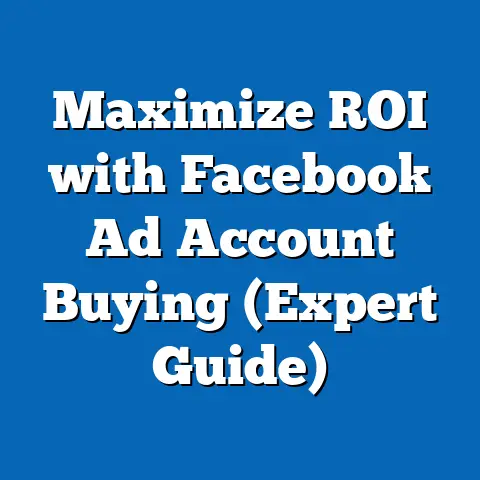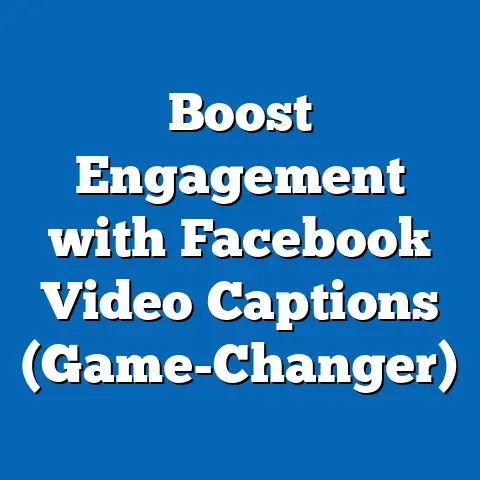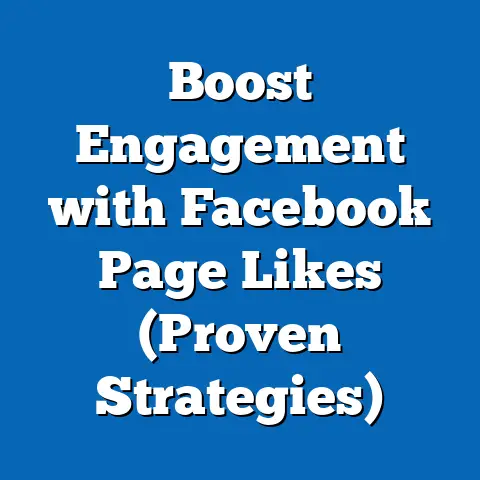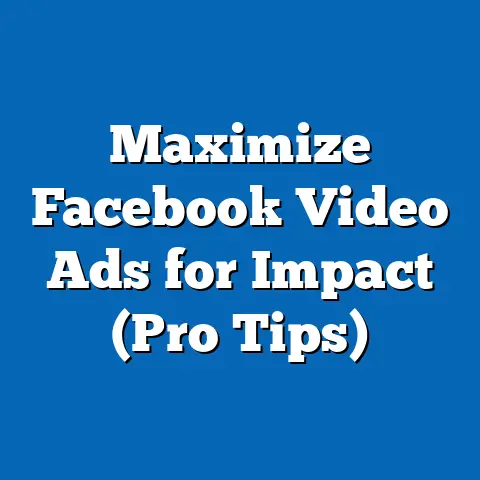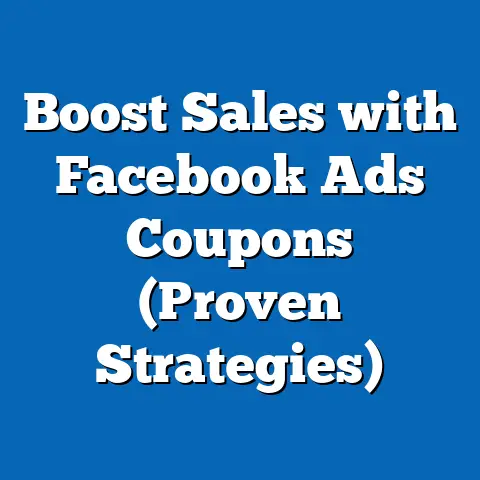Build Facebook Ads from Website (Expert Strategies)
Facebook advertising remains one of the most powerful tools for businesses to reach targeted audiences, drive traffic, and boost conversions. With over 2.9 billion monthly active users as of 2023 (Statista, 2023), the platform offers unparalleled access to diverse demographics across the globe. This guide will walk you through expert strategies for building effective Facebook ads directly from your website, leveraging data-driven insights, and optimizing for maximum return on investment (ROI).
Whether you’re a small business owner or a seasoned marketer, understanding how to integrate your website with Facebook’s advertising ecosystem can transform your digital marketing efforts. We’ll explore step-by-step processes, key trends, and actionable tips backed by statistics and case studies. Let’s dive into the world of Facebook advertising and unlock its potential for your brand.
Why Facebook Ads Matter: The Data Behind the Power
Facebook Ads have become a cornerstone of digital marketing due to their precision targeting and scalability. According to Hootsuite’s 2023 Digital Report, 78% of businesses worldwide use Facebook as a primary advertising platform, and companies spend an average of $1.07 per click on the platform (Hootsuite, 2023). This affordability, combined with the platform’s vast user base, makes it an attractive option for businesses of all sizes.
Moreover, Facebook Ads drive significant results. A 2022 study by WordStream found that the average conversion rate for Facebook Ads across industries is 9.21%, far surpassing other platforms like Google Ads, which hover around 3.75% (WordStream, 2022). These numbers highlight why integrating your website with Facebook Ads is not just a trend but a necessity for staying competitive in today’s market.
Demographically, Facebook’s audience is diverse, with 56% male and 44% female users globally (Statista, 2023). The platform also spans age groups, with 29% of users aged 25-34, making it the largest segment, followed by 18-24-year-olds at 23%. Understanding these demographics is crucial for tailoring your ads to the right audience, a topic we’ll explore later in this guide.
Step 1: Setting Up the Foundation – Integrating Your Website with Facebook
Before creating ads, you need to connect your website to Facebook’s advertising tools. This involves installing the Facebook Pixel, a small piece of code that tracks user behavior on your site and enables advanced targeting and analytics. According to Facebook, businesses that use the Pixel see a 20-30% increase in ad performance due to improved tracking and retargeting capabilities (Meta for Business, 2023).
To install the Pixel, log into your Facebook Ads Manager, navigate to the “Events Manager” tab, and generate a Pixel code. Place this code in the header section of your website’s HTML or use a plugin if you’re on platforms like WordPress. Once installed, verify its functionality using Facebook’s Pixel Helper tool to ensure data is being collected accurately.
The Pixel allows you to track actions like page views, purchases, and form submissions. This data is critical for building custom audiences and optimizing campaigns. For instance, a 2021 report by eMarketer noted that retargeting campaigns using Pixel data achieve a 70% higher click-through rate (CTR) compared to non-retargeted ads (eMarketer, 2021).
Step 2: Defining Your Goals and Audience
Every successful Facebook Ad campaign starts with a clear objective. Are you looking to drive traffic to your website, generate leads, or boost sales? A 2022 survey by HubSpot revealed that 62% of marketers prioritize brand awareness as their primary goal on Facebook, while 38% focus on conversions (HubSpot, 2022).
Once your goal is set, define your target audience using Facebook’s robust demographic and interest-based targeting options. For example, if you run an e-commerce store selling fitness gear, you can target users aged 18-35 who have shown interest in health and wellness. Facebook’s Audience Insights tool provides data on user behavior, showing that 45% of fitness enthusiasts engage with related content daily (Meta Audience Insights, 2023).
Demographic trends also play a role. Younger audiences (18-24) are more likely to engage with video ads, with a 31% higher engagement rate compared to static images, according to Sprout Social (2023). Tailoring your ad format and messaging to these patterns can significantly improve performance.
Step 3: Crafting Compelling Ads Using Website Data
With the Pixel in place, you can create ads that resonate with your audience based on their behavior on your website. Dynamic Ads are particularly effective, as they automatically pull product images, prices, and descriptions from your site to display personalized content. A 2022 study by Meta found that Dynamic Ads deliver a 34% higher return on ad spend (ROAS) compared to traditional image ads (Meta for Business, 2022).
Start by uploading your product catalog to Facebook through the Commerce Manager. Then, set up a Dynamic Ad campaign targeting users who have visited specific product pages or abandoned their carts. For instance, if a user viewed a pair of running shoes but didn’t purchase, a Dynamic Ad can remind them of the product with a tailored offer.
Visuals are key to ad success. According to a 2023 report by Social Media Examiner, ads with high-quality images or videos achieve a 40% higher CTR than text-heavy ads (Social Media Examiner, 2023). Use tools like Canva or Adobe Spark to create eye-catching visuals directly linked to your website’s branding.
Data Visualization Idea: Imagine a bar chart comparing the CTR of Dynamic Ads (34%) versus traditional ads (20%) over a 12-month period. This visual would highlight the effectiveness of personalized content in driving engagement.
Step 4: Optimizing Ad Placement and Budget
Facebook offers multiple ad placements, including the News Feed, Stories, Marketplace, and Audience Network. Placement impacts performance, with Stories ads showing a 25% higher engagement rate among Gen Z users compared to News Feed ads, according to a 2023 study by Kantar (Kantar, 2023). Test different placements to see what works best for your audience.
Budgeting is another critical factor. The average cost-per-click (CPC) on Facebook in 2023 is $1.07, but this varies by industry—e-commerce CPCs average $0.45, while legal services can reach $1.32 (Hootsuite, 2023). Start with a small daily budget (e.g., $10-$20) and use Facebook’s split-testing feature to compare ad variations. Scale up spending on high-performing ads to maximize ROI.
Historical trends show that ad costs fluctuate seasonally. A 2021 analysis by WordStream found that CPCs increase by 17% during the holiday season (November-December) due to heightened competition (WordStream, 2021). Plan your budget accordingly to avoid overspending during peak times.
Step 5: Retargeting and Lookalike Audiences for Growth
Retargeting is a powerful strategy for re-engaging users who have interacted with your website. Using Pixel data, you can create Custom Audiences of users who visited specific pages or added items to their carts. A 2022 report by AdRoll found that retargeted ads have a 10x higher CTR compared to display ads targeting new users (AdRoll, 2022).
Take retargeting a step further with Lookalike Audiences, which allow you to reach users similar to your existing customers. For example, if your website data shows that women aged 25-34 are your top buyers, a Lookalike Audience can target similar profiles. Meta reports that Lookalike Audiences increase campaign reach by 20-30% while maintaining relevance (Meta for Business, 2023).
Demographic patterns also influence retargeting success. Older users (35-54) are 15% more likely to convert from retargeted ads compared to younger users, according to a 2023 study by Nielsen (Nielsen, 2023). Adjust your messaging and offers based on these insights to improve results.
Step 6: Measuring Success and Iterating
Tracking performance is essential for refining your Facebook Ads strategy. Key metrics include CTR, conversion rate, and ROAS. A 2023 benchmark by WordStream shows that the average CTR for Facebook Ads is 0.90%, while top-performing campaigns achieve 2-3% (WordStream, 2023).
Use Facebook Ads Manager to analyze which ads drive the most website traffic or conversions. If an ad underperforms, tweak elements like the headline, image, or call-to-action (CTA). For instance, a 2022 experiment by Social Media Today found that CTAs like “Shop Now” outperform “Learn More” by 22% in e-commerce campaigns (Social Media Today, 2022).
Compare your results to historical data. In 2018, the average Facebook Ad CTR was 0.89%, showing minimal growth over five years (WordStream, 2018). This stagnation suggests that standing out requires continuous testing and innovation, especially as competition on the platform grows.
Data Visualization Idea: Picture a line graph tracking average Facebook Ad CTR from 2018 (0.89%) to 2023 (0.90%), overlaid with a second line showing top-performing campaigns (2-3%). This would illustrate the gap between average and optimized performance over time.
Trends Shaping Facebook Ads in 2023 and Beyond
The landscape of Facebook advertising is evolving rapidly. One major trend is the rise of video content, with 54% of marketers planning to increase video ad budgets in 2023, according to a survey by Wyzowl (Wyzowl, 2023). Short-form videos, especially in Stories and Reels, resonate with younger demographics, driving 30% more engagement than static ads among 18-24-year-olds (Sprout Social, 2023).
Privacy changes, such as Apple’s iOS 14.5 update in 2021, have also impacted ad tracking. A 2022 report by AppsFlyer noted a 15-20% drop in ad attribution accuracy due to reduced access to user data (AppsFlyer, 2022). This makes first-party data from your website, collected via the Pixel, more valuable than ever for maintaining targeting precision.
Another trend is the growing importance of AI-driven optimization. Facebook’s Advantage+ campaigns, which use machine learning to automate ad delivery, have shown a 12% improvement in ROAS compared to manual campaigns, per Meta’s 2023 data (Meta for Business, 2023). Experimenting with these tools can give your ads a competitive edge.
Demographic Insights: Tailoring Ads for Maximum Impact
Understanding demographic differences is key to crafting effective ads. For instance, men are 10% more likely to click on tech-related ads, while women show a 15% higher engagement with beauty and fashion content, according to a 2023 report by Statista (Statista, 2023). Age also plays a role—users aged 18-24 prefer trendy, fast-paced content, while those over 35 respond better to value-driven messaging.
Geographic targeting adds another layer of customization. A 2022 study by eMarketer found that urban users are 18% more likely to engage with Facebook Ads compared to rural users, likely due to higher internet penetration and disposable income (eMarketer, 2022). Use these insights to segment your audience and allocate budget effectively.
Cultural trends also influence ad performance. For example, during major holidays like Christmas or Diwali, ad engagement spikes by 25-30% in relevant regions, per Meta’s seasonal advertising report (Meta for Business, 2022). Aligning your campaigns with cultural events can amplify their impact.
Case Studies: Real-World Success with Website-Driven Facebook Ads
To illustrate these strategies, let’s look at two real-world examples. First, an e-commerce brand selling sustainable clothing used Dynamic Ads to retarget website visitors. By showcasing products users had viewed, they achieved a 3.2x ROAS and reduced cart abandonment by 40% within three months, according to a 2022 case study by Meta (Meta for Business, 2022).
Second, a local service provider used Lookalike Audiences to expand their customer base. After targeting users similar to their website visitors, they saw a 50% increase in lead generation at a 20% lower cost-per-lead, as reported by Social Media Examiner in 2023 (Social Media Examiner, 2023). These examples underscore the power of leveraging website data for ad success.
Challenges and Pitfalls to Avoid
While Facebook Ads offer immense potential, challenges exist. One common issue is ad fatigue, where users see the same ad too often, leading to a 14% drop in CTR after two weeks, per a 2023 study by Nielsen (Nielsen, 2023). Rotate creative assets regularly to keep content fresh.
Another pitfall is poor targeting. Overly broad audiences result in wasted spend, while overly narrow ones limit reach. A 2022 report by HubSpot found that 55% of marketers struggle with finding the right audience balance (HubSpot, 2022). Use A/B testing and Audience Insights to refine your targeting over time.
Finally, failing to optimize for mobile is a costly mistake. With 98.5% of Facebook users accessing the platform via mobile devices (Statista, 2023), ensure your website and ads are mobile-friendly. Slow load times can increase bounce rates by 32%, according to Google’s 2021 data (Google, 2021).
Broader Implications and Future Outlook
Building Facebook Ads from your website is more than a marketing tactic; it’s a strategic necessity in a digital-first world. As privacy regulations tighten and user expectations evolve, businesses must prioritize first-party data and personalized advertising to stay relevant. The 15-20% drop in attribution accuracy post-iOS 14.5 (AppsFlyer, 2022) signals a shift toward owned data sources like website tracking.
Looking ahead, AI and automation will redefine ad creation and optimization. Meta’s push for Advantage+ campaigns suggests a future where machine learning handles much of the heavy lifting, potentially leveling the playing field for small businesses. However, human creativity in messaging and visuals will remain irreplaceable.
Ultimately, the integration of website data with Facebook Ads offers a pathway to deeper customer connections and sustainable growth. By staying agile, testing relentlessly, and adapting to trends, businesses can harness this powerful tool to thrive in an increasingly competitive digital landscape.

